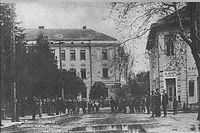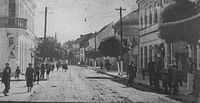Dubica, Bosnia-Herzegovina
| Kozarska Dubica Козарска Дубица Bosanska Dubica Босанска Дубица | ||
|---|---|---|
|
Highlights of Bosanska/Bosanska Dubica | ||
| ||
 Location of Dubica within Bosnia and Herzegovina | ||
| Coordinates: 45°11′N 16°48′E / 45.183°N 16.800°ECoordinates: 45°11′N 16°48′E / 45.183°N 16.800°E | ||
| Country |
| |
| Government | ||
| • Mayor | Mile Zlojutro (SDS) | |
| Area | ||
| • Total | 499,01 km2 (19,267 sq mi) | |
| Elevation | 104 m (341 ft) | |
| Population (2013 census) | ||
| • Total | 23,074 | |
| • Density | 46,2/km2 (1,200/sq mi) | |
| Time zone | CET (UTC+1) | |
| • Summer (DST) | CEST (UTC+2) | |
| Area code(s) | 52 | |
Dubica (Bosnian: Bosanska Dubica, Serbian: Kozarska Dubica/Козарска Дубица) is a town and municipality located in northern Bosnia and Herzegovina and is administratively part of the Republika Srpska entity. Dubica, for short, is situated in the eastern part of Bosanska Krajina region. The municipality of Hrvatska Dubica lies to the north, in Croatia. Dubica is situated 26 kilometres (16 miles) from the Zagreb–Belgrade Highway. The town and its suburbs border the Republic of Croatia to the north, the town of Bosanska Gradiška to the east, the town of Bosanska Kostajnica to the west, and the town of Prijedor to the south. The land area of Dubica is 499 square kilometres (193 sq mi) and the population is estimated at about 31,000, even though no census has been held since 1991.
Name
The town is originally known as "Bosanska Dubica" (Bosnian Dubica) but was renamed "Kozarska Dubica" (Козарска Дубица in Serbian Cyrillic) by the authorities of the Republika Srpska following the Bosnian War as part of a policy to purge out Bosnian prefixes.[1]
History
Early history


Bosanska Dubica was built in 930. However, the first mentioning of Bosanska Dubica dates from 1197. Babonići-Vodički were in charge of the town until the 12th century. Bosanska Dubica became an important fort during the Ottoman Empire due to its geographic positioning. It became a vital and important border crossing for many years. The last Austrian-Turkish war was the so-called Dubica War (1788–91) and was fought in this area. During the war in Dubica in the 1780s, the town, which was described at the time as having only a few houses and a mosque, was completely razed. The town fell under Ottoman occupation in 1538. Bosanska Dubica encountered many different rulers during the Ottoman Empire and the later Austro-Hungarian Empire.
From 1929 to 1941, Bosanska Dubica was part of the Vrbas Banovina of the Kingdom of Yugoslavia.
According to Serb historian Dragoje Lukic, as many as 14.287 residents (or 53% of the pre-war population), predominantly Serbs, were killed by the Ustashe and Germans during World War II, more than anywhere else on the territory of Yugoslavia.[2] During the 1970s Bosanska Dubica experienced a great improvement in its economy. During the 1980s there was a boom in construction and renovation which was halted by the outbreak of yet another war.
Bosnian War
During the Bosnian War (1992–95) about 6,000 Bosniaks were expelled from their homes, while many Serbs from Croatia settled in Bosanska Dubica often in those Bosniak homes. The bridge between Bosanska Dubica and Hrvatska Dubica was destroyed on the Bosnian side. During the war the city was under siege by the Croatian Defence Council in failed operation called Operacija Una 95. On 18 September 1995, the Croatian army made a descent across the Una river and took control of some parts of Dubica. At factory Knežopoljka they shot every civilian to come by on regional roadway. In all 44 civilians were killed.[3] The next day, on 19 September, Serb units from other parts of the front line came and forced the Croat army back over the river. That day Serb planes from the Banja Luka airport attacked the Croat army in vicinity of village Živaja and Šaš in Croatia. Suffering serious blows, the Croat army was defeated on the second day of their operation.[4]
The Serbian Orthodox Moštanica Monastery (Manastir Moštanica) appears on the Coat of arms of Bosanska Dubica/Kozarska Dubica.
Population
1910
According to the 1910 census, the absolute majority in the Bosanska Dubica municipality were Orthodox Christians (82.94%).
1971
30,384 total
- Serbs - 23,989 (78.95%)
- Bosniaks - 5,114 (16.83%)
- Croats - 717 (2.35%)
- Yugoslavs - 403 (1.32%)
- Others - 161 (0.55%)
1991
According to the 1991 census, the population of the Bosanska Dubica municipality was 31,577, including:
- 21,811 Serbs
- 6,470 Bosniaks
- 1,820 Yugoslavs
- 488 Croats
- 988 others
In the town itself, Muslims by nationality (Bosniaks) had a slight majority. During the Bosnian war, around 6,000 people, mostly Bosniaks, were forced to leave the town and municipality, while a similar number of Serb refugees from Croatia and/or other Bosnian towns, found shelter and settled in Bosanska Dubica.
Due to the war in Bosnia from 1992 to 1995, much of the traditional population of Bosanska Dubica was displaced outside of Bosnia and Herzegovina.
-
Monastery Moštanica is located near Kozarska Dubica
-

Serbian Orthodox church Sv. Sava
-

New Bosnian Mosque next to the City Council Building
Settlements
• Aginci • Babinac • Bačvani • Bijakovac • Bjelajci • Bosanska Dubica • Božići • Brekinja • Čelebinci • Čitluk • Čuklinac • Demirovac • Dizdarlije • Donja Jutrogošta • Donja Slabinja • Donji Jelovac • Draksenić • Furde • Gornja Gradina • Gornjoselci • Gradina Donja • Gunjevci • Hadžibajir • Hajderovci • Jasenje • Johova • Jošik • Kadin Jelovac • Klekovci • Knežica • Komlenac • Košuća • Koturovi • Kriva Rijeka • Maglajci • Malo Dvorište • Međeđa • Međuvođe • Mirkovac • Mlječanica • Mrazovci • Murati • Novoselci • Odžinci • Parnice • Pobrđani • Pucari • Rakovica • Sjeverovci • Sključani • Sreflije • Strigova • Suvaja • Ševarlije • Tuključani • Ušivac • Veliko Dvorište • Verija • Vlaškovci • Vojskova i Vrioci.
Economy
Situated in the valley of the rivers, the Municipality of Dubica has more than 316.09 square kilometres (122.04 sq mi) of arable land, thanks to which agriculture is an important development factor. Agricultural production is focused on land cultivation, cattle breeding industry, raising of industrial crops, and lately there has been the start of the development of fruit and wine growing.
Most of the economy comes from the livestock. The largest milk production company is the Mlijekoprodukt located near the town of Dubica. It continues its tradition of growing fruits in the area. The climate of Dubica is great for the cultivation of different kinds of vegetables.
Dubica also has an important construction company. It is called IGP "UNA". The company was established in 1962. All of the workers are completely qualified to work with different modern machines. Some important complexes that the company has built are: Zepter, the local hospital, the local high school, and the restoration of the severely damaged bridge.
Prior to the war there was a sugar factory operating as well.
Tourism

Hunting is a traditional sport of the Municipality of Dubica. One hunting organization is called 'Jele' (Deer) The area used for hunting is around 500 square kilometres (193 sq mi). Hunting is extravagant in Dubica since it has two big mountains Kozara and Prosara. The hunting area is filled with rich forests. Hunting ranges from deer to smaller animals such as wild ducks. Every April the international competition with dog hunting occurs in Dubica.
Spa Mlječanica is the center for physiatrics, rehabilitation, and health located in Dubica. It is in the northwest slopes of the mountain Kozara. The modern, specialized institution for physiatrics and rehabilitation, provides all the conditions for a successful recovery and rest for the clients.
Fishing is highly important in Dubica. Since, Dubica is located right on the Una River, fishing has developed into a long time tradition. People from different areas come to fish. Also the Sava is located not far from Dubica at Jasenovac, where the Una enters the Sava.
Sports
Dubica has an old tradition in sports that dates back to the early 20th century. In the 1930s Bosanska Dubica establishes a football club SK Una. After World War II, Dubica has an upsurge of different sport organizations. In 1962 the handball club Borac was established. Then on February 11, 1973, the basketball club BK Una was created. In 1982 the Karate Club Knešpolje was founded. Even today the different sports remain an important part of Dubica. There are both male and female teams for handball. Also there are a couple of karate clubs and chess clubs.
Culture

Every year outside Bosnia and Herzegovina, the annual Bosansko Dubičko Veče is held. It is a celebration that brings together displaced Bosnians (of all ethnicities) from Bosanska Dubica. The cities that hold the celebration in the United States are: Chicago and St. Louis. In Chicago it is always held on the Saturday before Memorial Day. It is hosted at the Rumija Cultural Center. Sydney, Australia, also holds the same celebration in order to gather Bosnians of Bosanska Dubica from different Australian and New Zealand areas. These are year-to-year celebrations that bring together Bosnians from Bosanska Dubica. There is work on creating a congress that would meet once every two years, in order to help young children, born outside Bosanska Dubica, retain the traditions and culture. The celebrations are primarily filled with Bosniaks, however, many Croats and Bosnian Serbs come to show their respect towards their town, Bosanska Dubica and reunite with former neighbours.
References
Notes
- ↑ Mitja Velikonja (2003). Religious Separation and Political Intolerance in Bosnia-Herzegovina. Texas A&M University Press. p. 259.
- ↑ "VI BILANS ZLOČINA NAD DJECOM KOZARE". Retrieved 11 January 2014.
- ↑ Savezna Republika Jugoslavija
- ↑ Eduard Šoštarić (14 August 2006). "Otvorena istraga zbog akcije 'Una'" [Inquiry into the Operation Una commenced] (in Croatian). Nacional (weekly). Archived from the original on 7 July 2012. Retrieved 7 July 2012.
External links
- Opština Kozarska Dubica
- Internet portal grada Kozarska Dubica
- Radio Feniks
- DUB Radio
- Nekretnine Kozarska Dubica
- Karta Kozarska Dubica
.svg.png)
